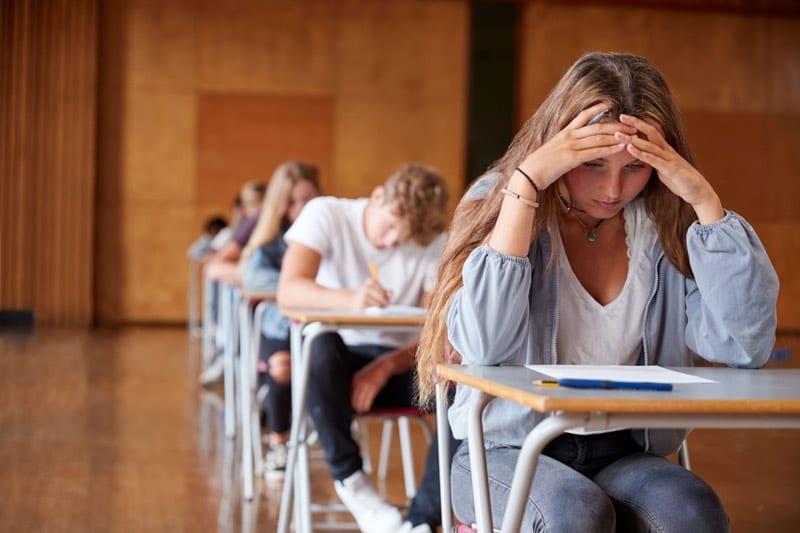The world has seen an alarming rise in the number of people experiencing anxiety due to constant added pressure or the troubled environments they may be a part of. And although adults can identify their symptoms quickly and opt for therapy, children may be unable to do so. According to the research reports, about 17% of school-going children experience anxiety. Some of them are never even diagnosed and receive no help with it.
School anxiety can also be situational, caused by the stress of final exams or peer pressure from other students. It is best to help young people in the early stages of the problem to help prevent panic attacks and other symptoms that can be even more disturbing.
Here are some signs to look out for to check if a student is struggling with anxiety:
- Reduced interaction in the classroom
- Increased absenteeism
- Problems in remembering and recalling important information
- Failure in concentrating and focusing on studies
- Struggling with maintaining a social life
- Avoiding participation in school activities
- Complaints about aches and pain, or imaginary illnesses
These signs of anxiety often show up in the classroom, which can hamper the learning process. Schools should adopt practices and regulations that help kids with anxiety. Phrases like “stay calm,” and “everything will be fine,” are not helpful to students with anxiety. Instead, educators and parents can try one of these tested methods to help students feel better in the classroom and at home.
Meditation and deep breaths
Deep breathing works well for people feeling anxious. Teachers can engage their classrooms in a breathing exercise routine to help students relax. Meditation can also aid in maintaining calm. You can introduce a routine for mindful exercise that can be beneficial for all students as it helps in improving memory and concentration.
Ask students to keep a journal
Often we take the little joys of life for granted, and that is what makes us unhappy and unsure of many things in life. Ask your students to maintain a journal and jot down all the positive things that happen in the day. They should also add a gratitude note for each day. Following this practice, students will be able to appreciate the good parts of their lives and shift their energy to optimism. Whenever your students feel anxious or low, ask them to read their journal as it can help them to calm down.
Help them release those happy hormones
A person who feels low or anxious may have fewer happy hormones such as serotonin in their body. To boost the release of these hormones, ask students to do some form of physical activity. From Zumba to running on the playground, any physical activity will help in elevating the levels of hormones that will lift their mood. This also works for adults, so next time you see someone anxious, ask him or her to go for a brisk walk or play music and dance.
Talk about it openly
It’s up to us adults to make sure we provide students with a healthy space where they can speak up about anything that is troubling them. Encourage them to share their concerns with you and try to help them see the brighter side of things. Healthy communication helps develop trust and eases their agitation. Let them know it is okay to feel anxious on some days, but they should also look for ways to make themselves feel better.
Walk and talk for one-on-one interaction
This method works wonders and can help kids open up more. Give them a break from the classroom and take them for a walk. This way, they can get fresh air and also be comfortable talking about their concerns with you. Keep walking and talking until they feel better. You can also ask them to notice the environment around them, such as trees, birds, and passersby.
Takeaway Thoughts
Students often find it challenging to keep up with their school obligations, sometimes due to peer pressure. Make home and school a place where kids can grow at the rate that’s natural for them without demanding that they always do better. A disturbed or stressed childhood can contribute to mental health disorders in adulthood, which is even more troublesome. Teachers should proactively talk about this to their students, and so should parents. Nourish your kids to see the great things the world has to offer and help them in knowing the ways to deal with their anxiety.
If you or someone you know experiences mental health issues, it is important to seek help from a qualified professional. Our Resource Specialist can help you find expert mental health resources to recover in your community. Contact us now for more information on this free service to our users.
About the Author: Sharon Vaughn is a full-time student counselor. After six years of practical experience in counseling students, she started writing blogs about various issues facing students in different phases of life. Sharon has expertise in content writing on anxiety, education, consultancy, marketing strategies, technology, and other new kinds of stuff. She has received multiple awards for her writing skills and magical words. For more information, you can visit https://www.sagarconsultants.co.uk/. Sharon lives in the USA with her family.
The opinions and views expressed in this guest blog do not necessarily reflect those of www.rtor.org or its sponsor, Laurel House, Inc. The author and www.rtor.org have no affiliations with any products or services mentioned in this article or linked to herein.
Recommended for You
- The Truth about Relapse in Addiction Recovery - April 14, 2025
- The Power of Peer Support in Mental Health Recovery - April 10, 2025
- Artificial Intelligence in Anxiety Management: How AI Helps Users Cope with Anxiety Symptoms - April 3, 2025





